- MOE
- National Parks of Japan
- Shiretoko National Park
- Characteristics
main body

Characteristics
Rich Ecosystems Linked by Ice Drifts and Majestic Landscapes of Mountains and Coastal Cliffs Created by Volcanic Eruptions
Date of Designation: June 1, 1964
Area: 38,954 ha
Related Prefecture: Hokkaido
Area: 38,954 ha
Related Prefecture: Hokkaido
The name "Shiretoko" derives from the Ainu phrase siretok, meaning "End of the Earth," and true to its name, the Shiretoko area is located on the most northeastern point of Japan (excluding the Northern Territories).
Shiretoko National Park is characterized by its majestically precipitous landscape, which was formed by volcanic activity and lava flows, and its richly diverse wildlife. In particular, the park is home to many large mammals, such as the brown bear and killer whale, and large birds of prey that are in danger of extinction. With these creatures at the top of the ecological chain, various wild animals interrelate and live strongly.
The diversity of these creatures and the links between ocean, river, and forest ecosystems in the area have been recognized, and in July 2005, Shiretoko was designated a World Natural Heritage site.
Shiretoko National Park is characterized by its majestically precipitous landscape, which was formed by volcanic activity and lava flows, and its richly diverse wildlife. In particular, the park is home to many large mammals, such as the brown bear and killer whale, and large birds of prey that are in danger of extinction. With these creatures at the top of the ecological chain, various wild animals interrelate and live strongly.
The diversity of these creatures and the links between ocean, river, and forest ecosystems in the area have been recognized, and in July 2005, Shiretoko was designated a World Natural Heritage site.
World Natural Heritage
In easy-to-understand terms, the characteristics/value of Shiretoko's natural environment for which the area was recognized as fulfilling the standards for a World Heritage site are (1) the blessings brought by the ice drifts; (2) the connection between the ocean and the land linked by the rivers; and (3) the precious wildlife sustained by the ocean, rivers, and forests.
<World Heritage Listing Requirement: "Ecosystem">
-Shiretoko is located at the lowest latitude of all seasonal sea-ice areas in the Northern Hemisphere. Influenced greatly by this, the area shows high productivity and provides a notable example of ecosystem interrelation between ocean and land.
<World Heritage Listing Requirement: "Biodiversity">
-Shiretoko is especially important for many land and marine animaland plant species, which include many rare species.
-Shiretoko is globally important for many salmonid fish and marine mammals such as Steller's sea lion and cetaceans.
-Shiretoko is important as a habitat for globally rare seabirds such as the spectacled guillemot as well as Steller's sea eagle, the white-tailed sea eagle, and other migratory birds.
<World Heritage Listing Requirement: "Ecosystem">
-Shiretoko is located at the lowest latitude of all seasonal sea-ice areas in the Northern Hemisphere. Influenced greatly by this, the area shows high productivity and provides a notable example of ecosystem interrelation between ocean and land.
<World Heritage Listing Requirement: "Biodiversity">
-Shiretoko is especially important for many land and marine animaland plant species, which include many rare species.
-Shiretoko is globally important for many salmonid fish and marine mammals such as Steller's sea lion and cetaceans.
-Shiretoko is important as a habitat for globally rare seabirds such as the spectacled guillemot as well as Steller's sea eagle, the white-tailed sea eagle, and other migratory birds.
Terrain/ Scenery

Shiretoko Mountain Range
Shiretoko Mountain Range
The Shiretoko peninsula is a long, narrow peninsula measuring approx. 70 km long and approx. 25 km wide at its base. From the top of Mt. Rausu-the main peak on the peninsula-is a spectacular view of precipitous mountains 1,200 m to 1,600 m in height rising on both sides in a row, as if emerging from the sea. Known as the Shiretoko Mountain Range, these mountains were created by volcanic activity.
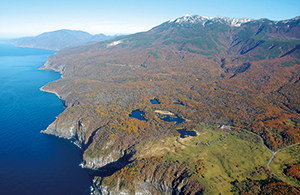
Cliffs
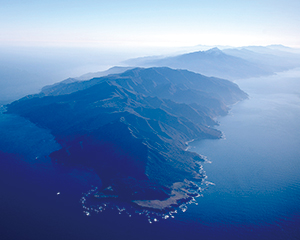
Cape Shiretoko
Cliffs
Along the coastline on the western side of the peninsula stretches a row of cliffs rising more than 100 m in height. These were formed by ice drifts fiercely eroding lava flows. Like the Frepe-no-taki Falls , groundwater flows between the rocks, transforming the cliffs into a multitude of spectacular waterfalls dropping into the Sea of Okhotsk. The ruggedness of these cliffs bars entry by humans and natural enemies, creating a valuable breeding ground for seabirds such as the spectacled guillemot.In contrast, on the eastern side of the peninsula, where there is no forceful contact with drift ice, the comparatively gentle coastline extends to the tip, and there are numerous kelp gathering stations dotted along the beach. In this way, one characteristic of Shiretoko is the different topographies that can be seen on the eastern and western sides of the peninsula, divided by the soaring Shiretoko Mountain Range running down the middle.
Plants
In precipitous Shiretoko, vegetation change can be observed at different altitudes at the shorter distance. Going in order from low-lying areas, mixed forests of conifers and broad-leaved trees such as Sakhalin fir, Quercus crispula Blume, and painted maple; forests of Erman's birch; and creeping pine zones. On land there are some 872 vascular plant species, of which 233 are alpine plants. These also include indigenous and rare species such as Viola kitamiana.
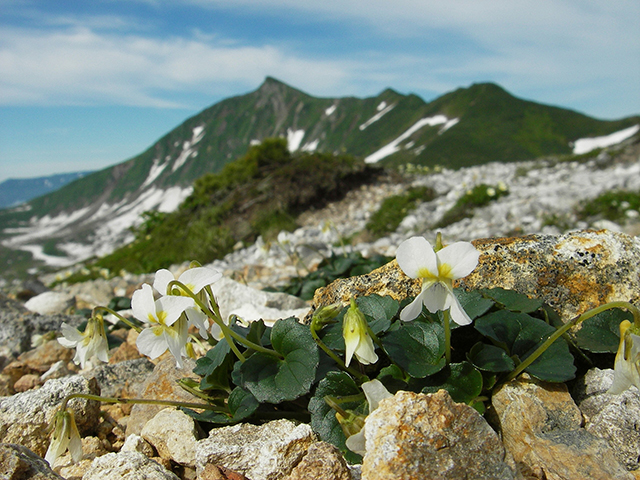
Viola kitamiana
Wildlife
With regard to mammals, 36 land mammal species and 22 marine mammal species have been confirmed as living in the park area. These include species, such as Steller's sea lion and the sperm whale, that are rare throughout the world. The animal most representative of Shiretoko, however, is the brown bear, which is Japan's largest land animal. Shiretoko Peninsula's brown bear population is estimated at several hundred, which is one of the highest population densities in the world.
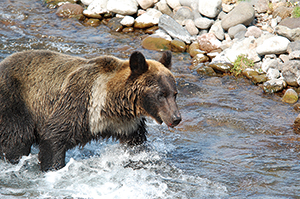
Brown Bear
Some 285 bird species have been recorded, and Blakiston's fish owls, which is an endangered species, white-tailed sea eagles, and black woodpeckers have been confirmed. Moreover, the national park and surrounding area is a globally important wintering place for Steller's sea eagles, more than 1,000 of which spend the winter here.
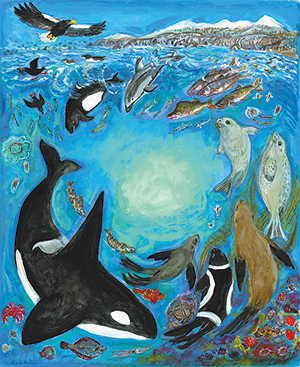
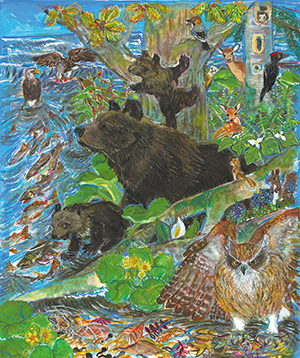
The reason that many wild animals can live within this small area in this way is the connection between the ocean, rivers, and forests that is unique to Shiretoko.
Ice drifts arriving at Shiretoko come bearing phytoplankton called ice algae. When the ice drifts melt in spring, the ice algae multiply explosively, and the zooplankton that eat the ice algae also proliferate. Juvenile salmonid fish eat the zooplankton as they depart Shiretoko, swimming in the ocean for several years before returning to Shiretoko. The salmon then swim upstream, becoming food for brown bears and eagles, providing the foundation for the land ecosystem.
Ice drifts arriving at Shiretoko come bearing phytoplankton called ice algae. When the ice drifts melt in spring, the ice algae multiply explosively, and the zooplankton that eat the ice algae also proliferate. Juvenile salmonid fish eat the zooplankton as they depart Shiretoko, swimming in the ocean for several years before returning to Shiretoko. The salmon then swim upstream, becoming food for brown bears and eagles, providing the foundation for the land ecosystem.
Culture
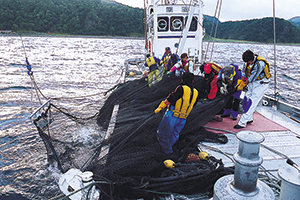
Salmon Fishing
Since ancient times, a culture has been cultivated in the Shiretoko area that treasures the abundant nature while hunting, fishing, and gathering plants.
Still the region's main industry today, fishing is sustained by a highly productive, richly abundant ocean, as fishermen endeavor to utilize fishery resources such as chum salmon, pink salmon, walleye pollack, and kelp in a sustainable way.
Still the region's main industry today, fishing is sustained by a highly productive, richly abundant ocean, as fishermen endeavor to utilize fishery resources such as chum salmon, pink salmon, walleye pollack, and kelp in a sustainable way.
